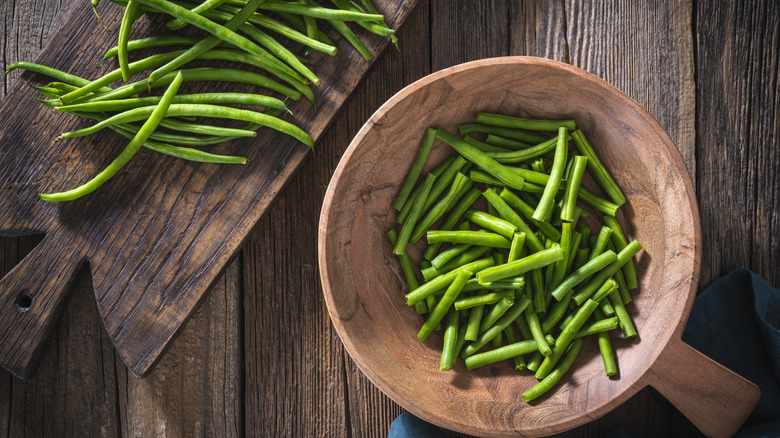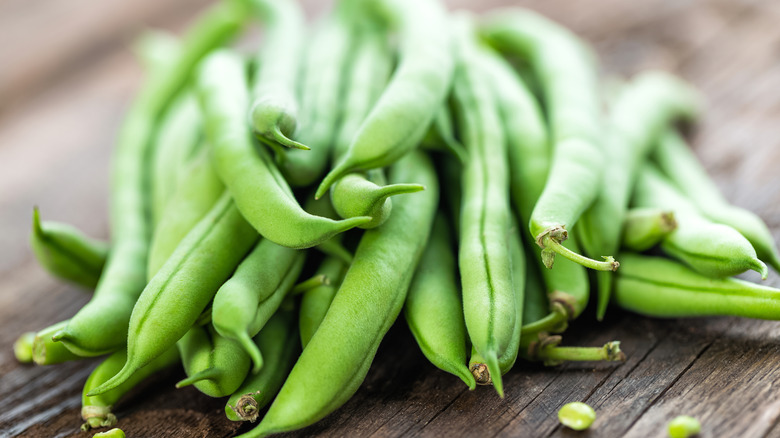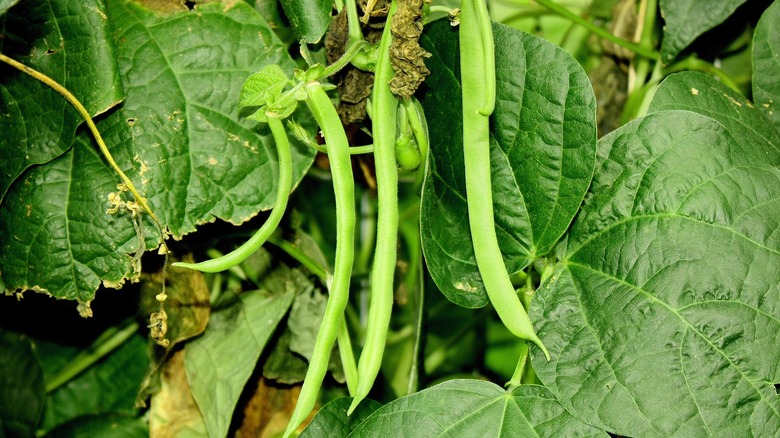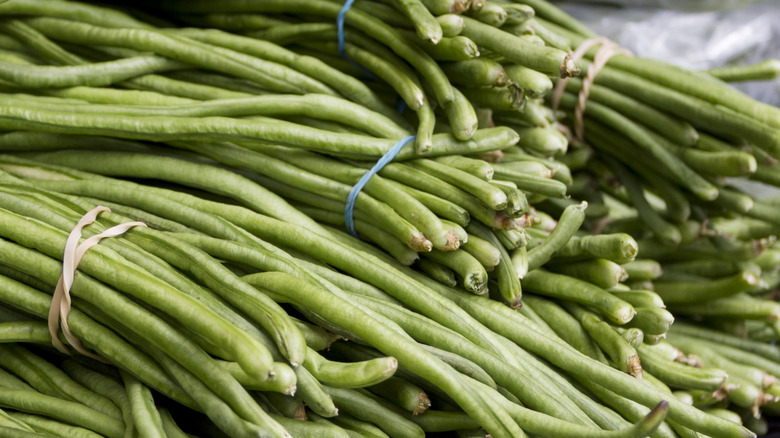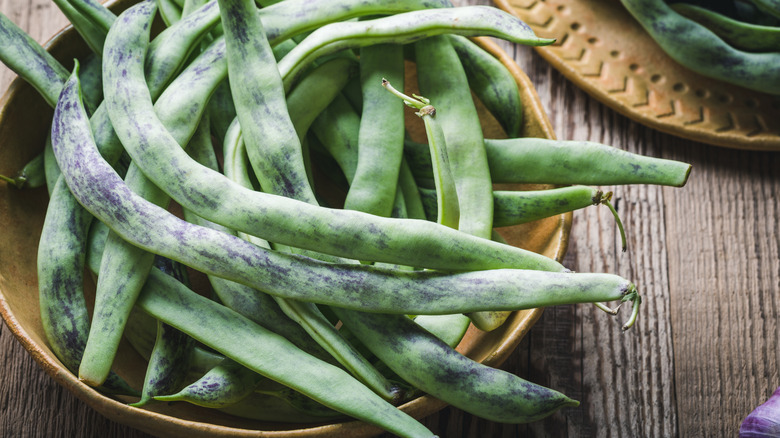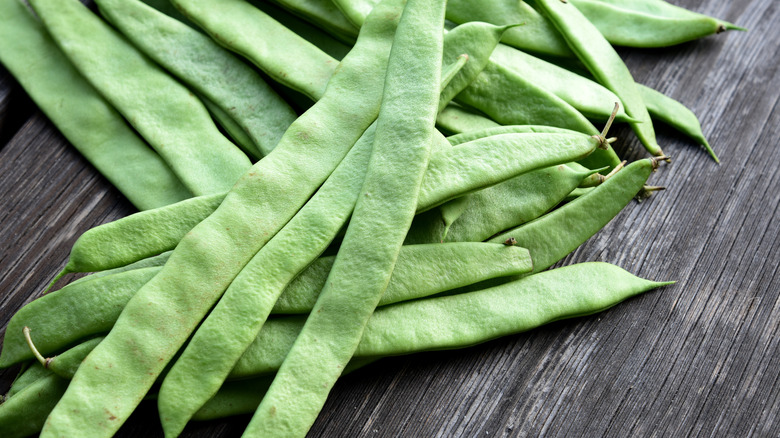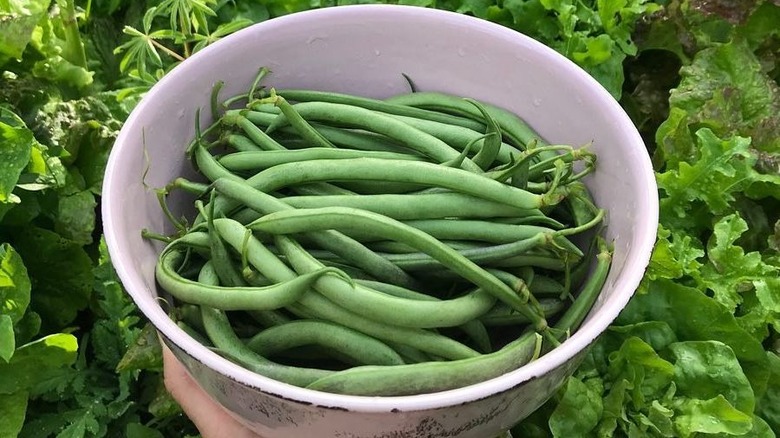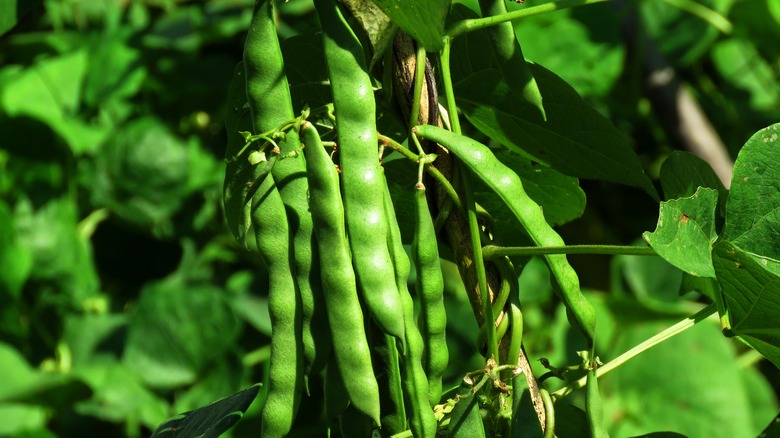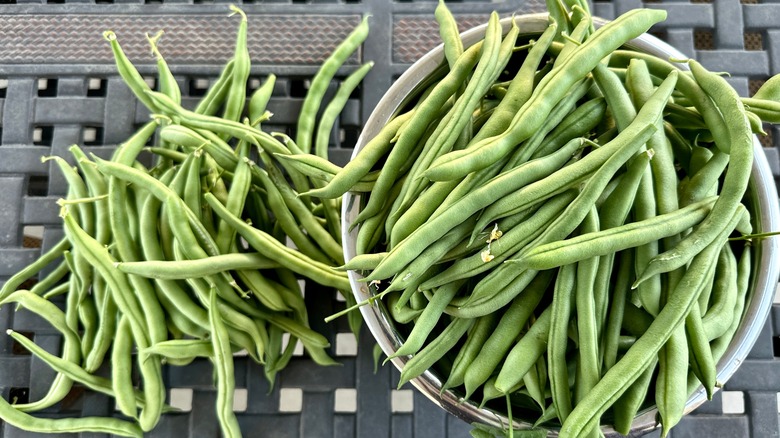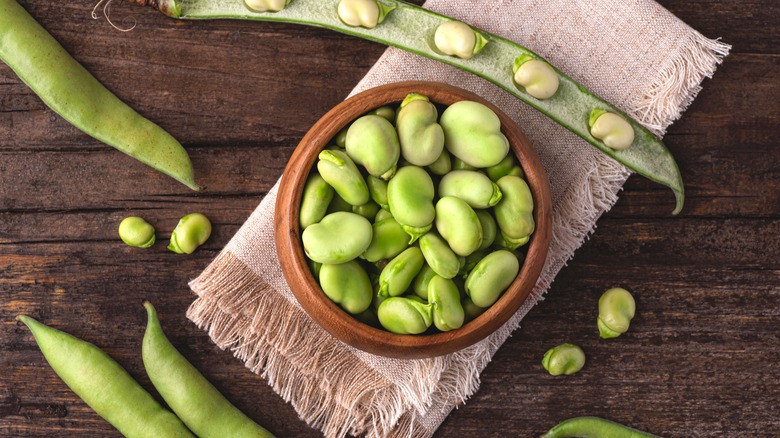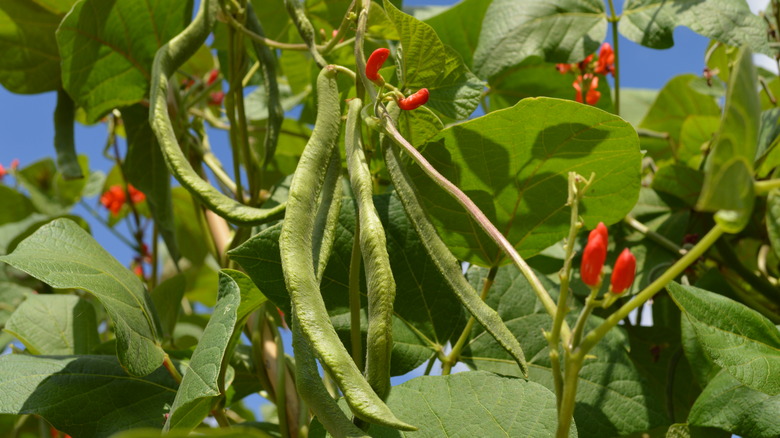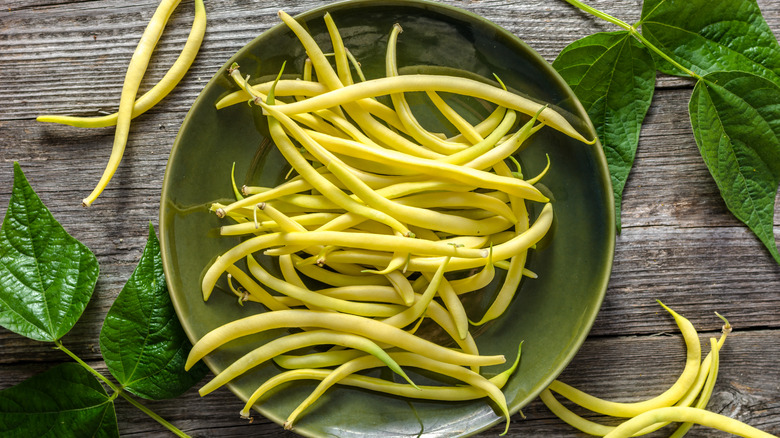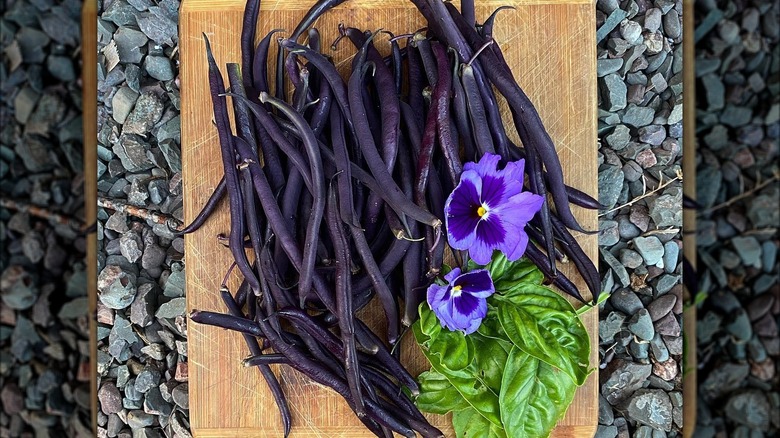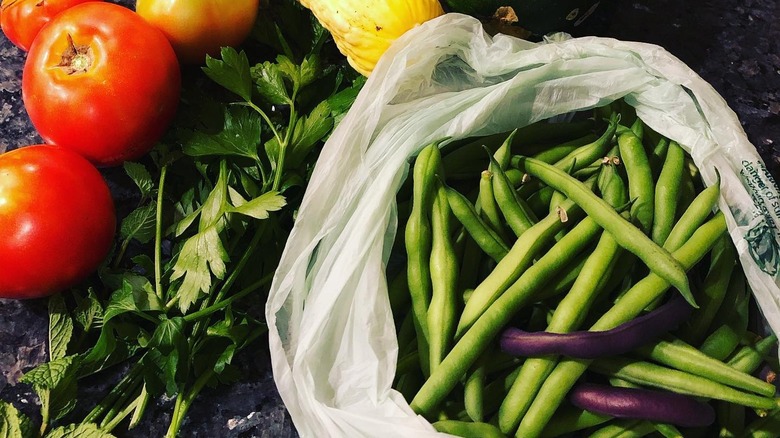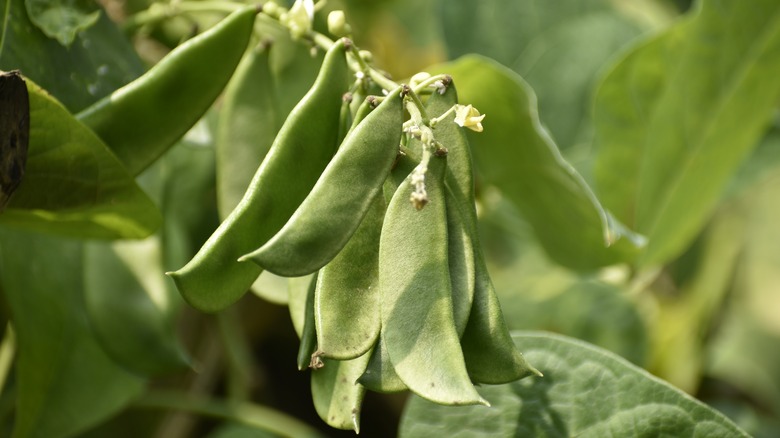14 Types Of Green Beans And How To Use Them
Nothing beats fresh green beans. While you can jump through hoops to make your canned variety taste better, why bother? Fresh green beans are vibrant and flavorful and can be prepared and eaten in a variety of ways, including raw, steamed, sauteed, or baked. There are plenty of delicious green bean recipes you can make year-round, including soups, stir-fries, and casseroles — and you're not restricted to just one type of bean. In fact, there are multiple varieties that you can use to up your veggie game.
Green beans have been cultivated for centuries. While you can find over 500 varieties around the world, there are two main types: bush and pole beans. As you might guess, bush beans grow on bushes, whereas pole beans grow on vines and often need supports like poles to help them grow. Nearly all varieties of green beans feature pods with seeds inside. However, they can come in a range of shapes, sizes, colors, and flavors. Here are some of the most popular types of green beans, as well as some tips on how to use them.
String beans
String beans are the classic beans many people think of when they think of green beans. In fact, they're often simply called green beans or snap beans by many people. String beans feature long green pods and they're typically harvested when they're about four to five inches long. Additionally, the string beans we eat today are either related to or inspired by the stringless bean varieties created by Calvin Keeney in the late 1800s.
One of the greatest things about string beans is the satisfying snap they make when you break them open or bite into one. When cooked properly, this type of green bean has a crisp texture and bright flavor that's slightly earthy and sweet. Plus, there are so many ways to cook string beans, from sauteeing to roasting to tossing them in brown butter. String beans also taste great when pickled and eaten as a snack, and can be used as a garnish in a Bloody Mary cocktail.
Kentucky wonder beans
Kentucky wonder beans were first introduced to the world in 1864. These green beans were originally called Texas pole beans or old homestead beans, before the seed company James J. H. Gregory & Sons renamed them Kentucky wonder in 1877 – and that's how most people refer to them today.
These popular pole beans are bright green and can grow pods up to 10 inches long. They are slightly more robust than regular string beans and have plenty of bite, which makes them perfect for braising and slow cooking. This type of green bean is a very common variety in the southern United States, so it should come as no surprise that they're often prepared as Southern comfort food dishes.
Many recipes suggest simmering the beans in water or broth (along with bacon and garlic) and then serving the beans with all the savory juices. If you want to prevent the beans from getting mushy, another technique involves freezing your green beans before cooking them to maintain that full-bodied flavor and texture.
Long beans
As the name suggests, these beans grow very long — up to four feet to be exact. Also called snake beans, asparagus beans, yardlong beans, or Chinese long beans, they're common all over Asia, and have been documented in China as far back as 1008 CE (though this green bean may have originally come from Africa).
Long beans look like string beans in many ways except they're slightly thinner. The texture is similarly crisp, though long beans taste slightly earthier and the pods can be a bit more fibrous. These lengthy legumes are incredibly versatile, as well, and can be used in a wide array of dishes.
These green beans work well in Asian dishes like Chinese restaurant-style green beans made in a garlic, soy, and oyster sauce, or spicy Szechuan green beans with chili flakes. To prepare them, simply trim the ends and chop them into pieces. One great green bean cooking tip for long beans is to blanch them before sauteeing to create a juicier final product.
Rattlesnake beans
It's easy to see how rattlesnake beans got their name. The beans have slender green pods streaked with purple markings that are somewhat similar to the patterns on rattlesnake skin. The pods also grow on twisting vines that wrap themselves around poles or other types of support, adding to their snake-like appearance.
Also called preacher beans, these legumes are native to the southwestern United States, where they grow well in the sandy soil. The beans are closely tied to the Hopi and Cherokee people, as well, who have been planting rattlesnake beans for many years. They're often eaten whole when young or shelled when older. They have strings running down the pods that you'll want to remove before cooking, as they can be tough.
Additionally, the pods lose their purple markings when cooked and turn a vibrant green. Inside rattlesnake beans are brown seeds that are meaty and slightly nutty. The beans are hardy enough to simmer away in soups and stews without disintegrating, which means they also work well in chilis and baked bean dishes. You can also steam, saute, or roast the whole beans just like you would with any other type of green bean.
Romano beans
If the name sounds slightly Italian, that's because Romano beans do, indeed, hail from Italy. These pole beans are also called Italian snap beans, Italian flat beans, or simply Italian pole beans. They have flat pods that can grow up to six inches long and range in hues from green to yellow, and even purple. The green ones are the most common, though, and just like string beans, they have a crisp texture and a delightfully sweet flavor (and the seeds are tender and mild).
There are so many things you can do with Romano beans. You can eat them straight off the vine or from the market, and there's no need to remove the pods. They're entirely edible, after all, and have a great snap when you bite into them. This makes Romano beans a great addition to salads or colorful crudité platters. Some cooks braise them with herbs and other veggies to make them tender and impart more flavor, but you can also grill this type of green bean, roast them, or pickle them.
Contender beans
If you love strong-tasting beans, contenders should be on your radar. They were introduced in the United States in 1949 and quickly became a popular choice with farmers and gardeners. Contenders are bush beans, so they don't need as much space to grow as pole beans. In addition, they tend to grow quickly. The straight, green pods grow to about six inches in length, and they have a good crunch and an intense green bean flavor.
Contender beans are delicious on their own or mixed in with other ingredients. Contender beans also don't have strings, so you won't have to worry about complicated prepping before cooking them. The uniform shape of the beans is perfect for a green bean trimming trick that can save you time, as well.
Simply line the beans up and slice all the tips off in one go. From there, you can toss the beans in a soup, salad, or stir-fry dish. The distinctive flavor of contenders also makes them a great choice for a traditional green bean casserole.
French beans (haricots vert)
French beans look very similar to string beans, which leads many people to believe the two are the same. Of course, there are some differences between string beans and French beans – for one, French beans actually come from France. Additionally, French beans (also known as haricots vert), are bred to have slim, ultra-tender pods, and the taste is sweet, earthy, and slightly grassy. Some also claim French beans are more tender than many of the green beans that grow in the U.S.
Now, despite the differences, anything you can do with string beans? You can also do with French beans. But if you are going to go the French bean route, we recommend trying some seriously delicious French recipes. For example, you may want to dress your green beans in a tangy, garlicky vinaigrette, or try a green bean almondine featuring haricots vert cooked in butter and lemon juice and topped with crunchy almonds. The beans also taste great in quiche Lorraine or alongside mains like Chateaubriand and chicken cordon bleu.
Blue Lake beans
Blue Lake beans are unique to the United States. They get their name from the Blue Lake area of California where the variety was created in the early 1900s. The beans were first developed for canning, but the crispness and mild, grassy flavor made them popular in fresh form, as well. Blue Lake beans became even more popular when stringless varieties were developed in the 1960s.
Blue Lake beans have long, straight, green pods that grow about six inches long. The bright flavor of Blue Lake beans makes them a great addition to summery salads. For a plant-based dish packed with protein and flavor, consider making a three-bean salad with Blue Lake beans as the star. You can also add these green beans to potato salad to add a splash of color and extra crunch. If you go the salad route, though, remember that one of the biggest mistakes to avoid with bean salads is not draining green beans properly before assembling the dish.
Fava beans
Also called broad beans, fava beans have a history that dates back thousands of years, and you can find them on nearly every continent in the 21st century. These tasty green beans have large pods with seeds that are white or light green. The pods typically grow about six inches long, but can grow as long as 12 inches, and these green beans have a rich, nutty flavor.
Most people peel fava beans or buy them pre-peeled, and only eat the seeds. However, you don't have to peel your fava beans if you don't want to because they can be eaten whole – pod and all. The younger beans can be very tender and have a slightly sweet taste, while the older the beans get, the more fibrous the skin will be.
If you want to try fava beans whole, consider grilling them to give them a nice char or blistering the green beans to enhance the earthy flavor. Peeled fava beans can be used in soups, pastas, and salads, and the beans can also be pureed to make an Italian-style dip. If you have dried beans consider using them in a fava-licious twist on a classic falafel sandwich.
Scarlet runner beans
With a name like scarlet runner beans, you might think these beans would be bright red. But these beans get their name from the plant's vibrant red flowers, and the pods on the vine are green and look very similar to string beans. Pop the pods open, though, and you'll find seeds that can range in color from black with red patches, white with black splotches, and purple.
Nearly all parts of this plant are edible, including the seeds, pods, flowers, and roots. However, many scarlet runner bean recipes call for just the beans without the pods. The beans are quite firm, which means they may take slightly longer to cook than other types. Scarlet runner beans are a great addition to soups or stews because, when simmered, they lose some of their grainy texture and take on a luscious creaminess.
That being said, one of the biggest mistakes everyone makes when cooking beans is overcooking them. To avoid turning your scarlet runners into a mushy mess, check on your beans throughout the cooking process to ensure the texture is on point.
Wax beans
Technically wax beans aren't green — they're yellow. So why are they included on our list? Well, one of the false facts everyone believes about green beans is that they can only be green. The truth is green beans come in a variety of colors including green, yellow, and purple.
Wax beans are essentially the same as string beans except that they don't have the chlorophyll to make them green. Otherwise, they have a very similar taste to their more verdant siblings. Also, don't let the name fool you: the texture of wax beans is crisp outside and tender inside.
If you want to add a bit of color to your green bean dishes, throw in a few wax beans to increase the visual appeal. Wax beans can be used in place of a regular green variety in numerous recipes, after all. Some creative ways to use wax beans include adding them to a classic Nicoise salad, dredging them in batter and deep-frying them tempura-style, or pickling them and adding them to salads or sandwiches.
Royal burgundy beans
Speaking of colorful beans, royal burgundy beans are easily identifiable for their deep purple color. In this case, it's not chlorophyll or lack thereof that affects the color — it's a pigment called anthocyanin that gives these beans their alluring hue. Anthocyanin is also what gives red onions, red cabbage, plums, and grapes their purple or reddish colors.
Royal burgundy beans have pods and seeds that can range from deep purple to violet. They have a crisp exterior and tender beans that taste slightly nutty. You may be surprised to find, though, that once you start cooking your royal burgundy beans, the purple fades and they turn green. You can thank pH levels for that, as anthocyanin needs acidity to sport its vibrant hues.
If you don't want the green color of the beans to shine through, there is a way to keep your royal burgundy beans purple. Soak them in some sort of acid like lemon juice beforehand, then cook the green beans very lightly or eat them raw to maintain the original color when dining.
Kentucky Blue beans
With so much talk about oddly colored green beans, you might think that Kentucky Blue beans are another type to add to that list. But these green beans are actually green, and the name is a mash-up of Kentucky Wonder and Blue Lake — the two types of beans that were crossbred to create this variety.
Like their parent beans, Kentucky Blue beans have long, straight pods with tender beans inside. They are snappy when raw and have a sweet, earthy flavor. They're also a favorite green bean with gardeners because they give great yields. Kentucky Blues can grow up to seven inches long, which makes them a substantial green bean to use as a side dish.
If you want a quick and easy addition to your meal, consider air fryer garlic green beans with a Kentucky Blue batch. The air fryer cooks the beans, while still retaining their crunchy texture. A slow cooker green bean casserole is another time-saving dish. Just pop the ingredients in the slow cooker and let the device do the work for you while you run errands or watch TV.
Lima beans
Although most everyone pronounces lima beans as "lime-ah" beans, the beans are named after the capital of Peru, which is pronounced "lee-mah." These flat, moon-shaped green beans are also called butter beans, which is a nod to their rich, buttery texture and flavor when cooked. While these beans originated in South America, they've became a common crop in the southern United States, so you'll find plenty of southern recipes that feature lima beans like Kentucky burgoo.
Lima beans often get a bad rap because they can taste quite bitter when overcooked. However, when prepared properly, they can be creamy and nutty. The only catch is they need to be thoroughly cooked — as in all the way through — because the raw beans contain linamarin, which turns into cyanide when it's digested.
Thankfully, cooking lima beans destroys that compound, and a good rule of thumb is to cook them for about 30 minutes in a pot of water or a pressure cooker. After this, you can add them to soups, mash them into a dip, or cook them with bacon and serve them as a side dish.
